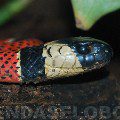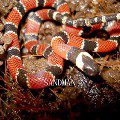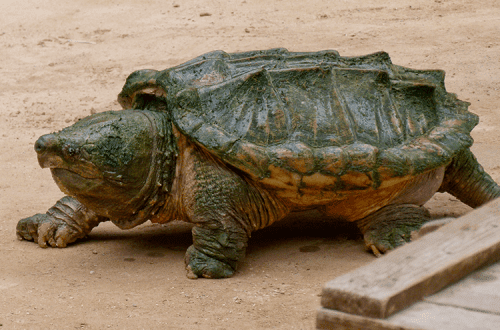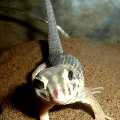
Asp coral
Representatives of this species of snakes lead a predominantly nocturnal secretive lifestyle. It is rarely found in open space, although there are situations when the coral snake is found near human habitation. He prefers either a cool, wet curing bud or a sandy bud. Asps appear extremely rarely on the surface, this happens during the rains and during the breeding season.
The body length of this snake reaches 60-70 cm. The head is blunt, small in size. The tail is also not very long – about 10 cm. The mouth is slightly stretched. The color of the coral snake is very impressive. The main color is red, which is interrupted by surrounding the body, correctly placed black rings.
Classification
Kingdom: Animalia (animals)
Type: Chordata
Class: Reptilia (reptiles)
Order: Squamata (scaly)
Suborder: Serpentes (snakes)
Family: Elipidae (aspididae)
Species: Micrurus corallinus (coral snake)
Inhabitation
The coral asp lives in the forests of Eastern Brazil, further south up to the Mato Grosso plateau. She leads a secretive lifestyle, mostly nocturnal. It is rarely seen in open areas, although this asp is also found even near human habitation. It does not live in swamps, preferring either sandy soil or moist, cool forest soil, where it takes refuge in shrubs and fallen leaves. Representatives of this species of snakes are extremely difficult to find and catch, as they spend most of their lives either hiding in the rainforests in fallen leaves, or digging into the ground. Snakes try to crawl out to the surface during the breeding season or in the rain.
Description
 The body length of the coral asp varies from 60 to 70 cm. The head of this species is small and blunt, a short tail (about 10 cm) crowns the valky body. The mouth is not large, slightly stretched.
The body length of the coral asp varies from 60 to 70 cm. The head of this species is small and blunt, a short tail (about 10 cm) crowns the valky body. The mouth is not large, slightly stretched.
The color of this snake is very bright. The base color is red, which is interrupted by black rings that surround the body and are quite regularly spaced, on the front and back edges the black ring is separated from the red by narrow white-green rings. All white-green and red rings are studded with black dots, since each scale has a black tip. The snake’s head is black-blue from the anterior half to the posterior end of the frontal shield. On both occipital scutes, a wide transverse greenish-white stripe begins, which descends behind the eye and occupies the lower jaw. Behind her is a black collar, which is the first black ring before the red one. As for the tail, most often it has about eight whitish rings on a black background and a white short tip. The coral asp sheds about six times a year, often and very willingly drinks, but prefers not to go down into the water.
This snake bites a person quite rarely, under emergency circumstances. In case of ineffective bites of this snake, a characteristic feature is the absence of a clinical picture, as well as the development of only preparalytic and local symptoms, despite the fact that several lethal doses of yaz may be contained in the glands of this snake. In cases of an ineffective bite, the clinical picture can develop almost instantly and is extremely poorly suppressed by symptomatic therapy. The wound at the site of the bite, especially when it comes to the lower limbs, can be almost invisible, since the teeth of the coral asp are small. As for pain, they are inconsistent signs with the bites of these snakes. Vomiting is the most common symptom after an asp bite. It can be both single and take a “profuse” character. Attacks can begin 5-10 minutes after the bite, vomiting can be with blood, usually this is preceded by prolonged bleeding from the wound. A severe headache may also occur. In case of poisoning with coral asp venom, some proteinuria is noted. In rare cases, acute cardiovascular failure even before the development of paralytic symptoms can be fatal. This is due, among other things, to the cardiotoxic effect of coral snake venom.
Furrowed teeth are in front in the upper jaw. The venom gland lies superficially on the bones of the skull, behind the eye. The coral asp, however, like all representatives of the asp family, uses two small teeth that are located on the upper jaw to bite. Unlike, for example, vipers, which prefer to immediately release the victim after an attack and which have retractable fangs, coral asps during a bite try to hold their prey as tightly as possible with their teeth so that the effect of the poison is more effective. After such “chewing” the snake leaves about 15-16 traces of palatine teeth, lower jaw and pterygoid bones. With a “sliding” bite, when the skin is scratched, the chance of minimal poisoning increases.
Food
This snake feeds mainly on various amphibians, large insects and small lizards. They can also eat reptiles and even birds. And in captivity, when choosing a diet for this snake, you need to be guided by its diet in the wild. You can use Madagascar cockroaches, crickets, small mice, earthworms. An asp can do without food for quite a long period, but the lack of water affects the snake detrimentally already for 3-5 days, so there should always be clean water in the drinker.
The coral asp feeds on reptiles, various amphibians, large insects, and sometimes even birds. In captivity, the diet may consist of crickets, earthworms, and small laboratory mice. Also, there should always be clean water in the drinking bowl – the coral asp drinks a lot. The coral asp is an egg-laying snake. The mating season occurs once a year after hibernation. The clutch usually contains 2-3 eggs.
Additionally
 Previously, the name Elaps was applied to coral asps, now this genus is called Micrurus.
Previously, the name Elaps was applied to coral asps, now this genus is called Micrurus.
Brazilians have a belief that the coral asp carries another small snake in its neck that bites.
Coral snakes, unlike other snakes, are most mobile in hot weather conditions.
In nature, there are several types of non-venomous snakes that mimic the color of coral asps, these include the striated king snake and the milk snake. In North America, in order to distinguish a non-venomous mimic from a poisonous coral asp, attention must be paid to the order of the rings. There is even a saying “Red with yellow – promises death, and red with black – does not harm.” However, this rule can only be applied with certainty to those coral snakes that are common in the eastern and southern territories of the United States, in other parts of the world coral snakes can have completely different colors: only blue and pink rings can be present, red rings can touch black rings. , or there may be no rings at all.
In the US, coral snakes account for less than one percent of all snake bites, as these snakes are not very aggressive and are not prone to attack. The majority of bites occur during casual contact, such as gardening.
Sources of
http://www.megabook.ru
http://dic.academic.ru
http://www.povodok.ru
http://www.polykhrest.od.ua
http://slovarik.net
Reproduction
Representatives of this species are oviparous species. The mating season for the coral snake occurs once a year. Waking up from hibernation, the female exudes pheromones, and with such force that it attracts a huge number of males, which form a huge moving ball. Like most snakes, the male coral asp has a paired copulatory organ, which is located on opposite sides of the snake’s body, respectively, the male uses the penis that is closer to the female. Already towards the end of summer, the female lays a clutch, which usually contains 2-3 eggs. She arranges a nest for herself either in an earthen hole or in a pile of fallen leaves, protecting the eggs from temperature changes, environmental dangers, warming them with the heat of her own body. At these moments, coral asps are extremely aggressive – protective reactions work in a snake with lightning speed.
Content
 Keeping any poisonous snakes, including the coral snake, is far from a safe occupation. It is simply not safe to keep such a snake in a terrarium; it is better to eat a specially equipped room under the terrarium. The ideal option is a bright room with a terrarium standing right next to the wall, and with carefully smeared cracks, including even ventilation holes. The light must be constant – a snake in the dark sees much better than a person. The terrarium, like the room itself, will need to be locked. For maintenance, you will need to pick up a strong, thick-walled terrarium. The presence of cracks in it is not permissible – small asps are extremely mobile, and adults can bite through the hole found. To handle these snakes, you will need to purchase special devices – tongs or clamps to limit the mobility of the snake, hooks of various sizes, spoons and buckets for feeding, plexiglass shields. When processing asps, taking them with bare hands is deadly, so protection must be taken care of in advance. And you should always keep on hand the serum from the poison of this snake.
Keeping any poisonous snakes, including the coral snake, is far from a safe occupation. It is simply not safe to keep such a snake in a terrarium; it is better to eat a specially equipped room under the terrarium. The ideal option is a bright room with a terrarium standing right next to the wall, and with carefully smeared cracks, including even ventilation holes. The light must be constant – a snake in the dark sees much better than a person. The terrarium, like the room itself, will need to be locked. For maintenance, you will need to pick up a strong, thick-walled terrarium. The presence of cracks in it is not permissible – small asps are extremely mobile, and adults can bite through the hole found. To handle these snakes, you will need to purchase special devices – tongs or clamps to limit the mobility of the snake, hooks of various sizes, spoons and buckets for feeding, plexiglass shields. When processing asps, taking them with bare hands is deadly, so protection must be taken care of in advance. And you should always keep on hand the serum from the poison of this snake.





